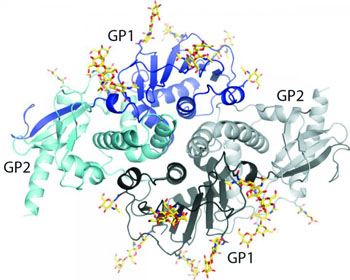X-Ray Crystallography Reveals Structure of the Arenavirus Binding Complex
By LabMedica International staff writers
Posted on 11 May 2016
A team of molecular virologists has established the three-dimensional structure of the intensely studied research tool, Lymphocytic choriomeningitis mammarenavirus (LCMV).Posted on 11 May 2016
LCMV and the closely related, but much deadlier Lassa fever virus are arenaviruses, which exist worldwide and cause hemorrhagic fevers and neurological disease. These viruses are characterized by a single glycoprotein expressed on the viral surface that mediates entry into target cells. This glycoprotein, termed GPC, contains a membrane-associated signal peptide, a receptor-binding subunit termed GP1, and a fusion-mediating subunit termed GP2. Although GPC is a critical target of antibodies and vaccines, the structure of the metastable GP1-GP2 prefusion complex has remained undetermined for all arenaviruses.

Image: The structure gives scientists a new view of Lymphocytic choriomeningitis mammarenavirus (LCMV), a close relative of the Lassa fever virus (Photo courtesy of the Ollmann Saphire Laboratory, The Scripps Research Institute).
When LCMV attacks a cell, attachment of the virus to host receptors through its surface glycoproteins initiates the process of replication. The virus is encapsulated into a vesicle inside the host cell, which creates a fusion of the virus and vesicle membranes. The viral ribonucleocapsid is then released into the cytoplasm of the host cell. The RNA-dependent, RNA-polymerase brought along with the virus initially binds to a promoter and begins transcription from negative-stranded to a positive-stranded mRNA. The formation of a strong hairpin sequence at the end of each gene terminates transcription. The mRNA strands are capped by the RNA-dependent, RNA-polymerase in the cytoplasm and are then subsequently translated into the four proteins essential for LCMV assembly. The ribonucleocapsid interacts with the Z matrix protein and buds on the cell membrane, releasing the virion to exit the infected cell.
In a paper published in the April 25, 2016, online edition of the journal Nature Structural & Molecular Biology, investigators at The Scripps Research Institute (La Jolla, CA, USA) described results of a long-term X-ray crystallography study that elucidated the crystal structure of the fully glycosylated prefusion GP1-GP2 complex of LCMV at a resolution of .35 nm.
The "double dimer" structure that was obtained revealed the conformational changes that the arenavirus glycoprotein must undergo to cause fusion and illustrated the fusion regions and potential oligomeric states.
"LCMV has been a beacon that has illuminated immunology and virology for decades," said senior author Dr. Erica Ollmann Saphire, professor of immunology and microbial science at The Scripps Research Institute. "This structure provides the missing roadmap to understand how to defend against its extremely lethal cousin, Lassa virus. It has moving parts. LCMV now looks like it sits between class I and class II viruses, making this structure a possible "fossil" of an intermediate evolutionary process."
Related Links:
The Scripps Research Institute














